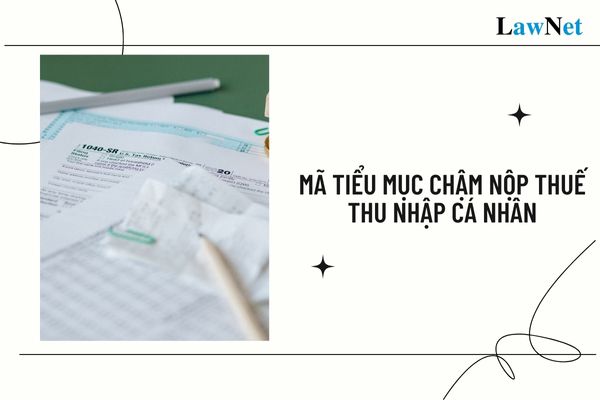What is the sub-entry for late payment of PIT in Vietnam? How is the late payment of PIT calculated?
What is the sub-entry for late payment of PIT in Vietnam?
According to point b, clause 1, Article 4 of Circular 324/2016/TT-BTC, a sub-entry (also known as an economic content code) is a detailed classification of an entry, used to classify detailed state budget revenues and expenditures according to management subjects in each entry.
Based on Appendix 3 of the list, sub-entries issued together with Circular 324/2016/TT-BTC supplemented by clause 5 Article 1 of Circular 93/2019/TT-BTC stipulates that the sub-entry for late payment of personal income tax is 4917.

What is the sub-entry for late payment of PIT in Vietnam? How is the late payment of PIT calculated?
How is the late payment of PIT calculated in Vietnam?
Based on clause 2, Article 59 of the Law on Tax Administration 2019 the stipulations are as follows:
Handling of late payment of taxes
...
2. The calculation of late payment fees and the calculation period is stipulated as follows:
a) The late payment fee rate is 0.03% per day based on the late tax amount;
b) The period for calculating late payment fees is counted continuously from the day following the day the late payment arises as stipulated in clause 1 of this Article to the day immediately preceding the day the tax debt, tax refund recovery, increased tax, imposed tax, or late transferred tax has been paid into the state budget.
...
Thus, the late payment fee for PIT for 1 day is calculated using the formula:
Late payment fee rate = 0.03% x Late tax amount.
What income types are subject to personal income tax in Vietnam?
According to Article 3 of the Personal Income Tax Law 2007 as amended by clause 2 Article 2 of the Law on Amendments to Various Tax Laws 2014, clause 1 Article 1 of the Amended Personal Income Tax Law 2012, the taxable personal income includes the following types of income, except for income exempt from tax as stipulated in Article 4 of the Personal Income Tax Law 2007:
(1) Income from business activities, including:
- Income from production, trading of goods, services;
- Income from independent practice of individuals with a license or practice certificate in accordance with the law.
Income from business as stipulated in this clause does not include income of individuals doing business with an annual revenue of 100 million VND or less.
(2) Income from salaries, wages, including:
- Salaries, wages, and other revenues of a salary or wage nature;
- Allowances, subsidies, except for:
Allowances, subsidies as prescribed by law on preferential treatment for people with meritorious services; defense, security allowances; hazardous, dangerous allowances for professions or jobs in special working conditions; attraction allowances, area allowances as prescribed by law; sudden difficulty, labor accident, occupational sickness allowances, one-time maternity or adoption allowances, allowances for reduced labor capacity, one-time retirement benefits, monthly death benefits, and other benefits as prescribed by social insurance law; severance, job loss allowances as prescribed by the Labor Code 2019; social protection allowances and other non-salary, non-wage allowances according to regulations by the Government of Vietnam.
(3) Income from capital investment, including:
- Loan interest;
- Share dividends;
- Income from capital investment in various forms, except for income from government bond interest.
(4) Income from capital transfers, including:
- Income from transferring capital in economic organizations;
- Income from securities transfer;
- Income from capital transfer in other forms.
(5) Income from real estate transfers, including:
- Income from transferring land use rights and assets attached to the land;
- Income from transferring ownership rights or use rights of residential houses;
- Income from transferring land lease rights, water surface lease rights;
- Other income received from real estate transfer in any form.
(6) Income from winnings, including:
- Lottery winnings;
- Prizes from promotional activities;
- Prizes from betting activities;
- Prizes from games, competitions with prizes and other types of winnings.
(7) Income from copyright, including:
- Income from the transfer, licensing of intellectual property rights;
- Income from technology transfer.
(8) Income from franchise.
(9) Income from inheritance that is securities, capital portion in economic organizations, business establishments, real estate, and other assets subject to ownership or use registration.
(10) Income from gifts that are securities, capital portion in economic organizations, business establishments, real estate, and other assets subject to ownership or use registration.

